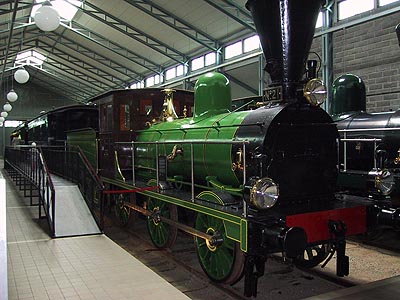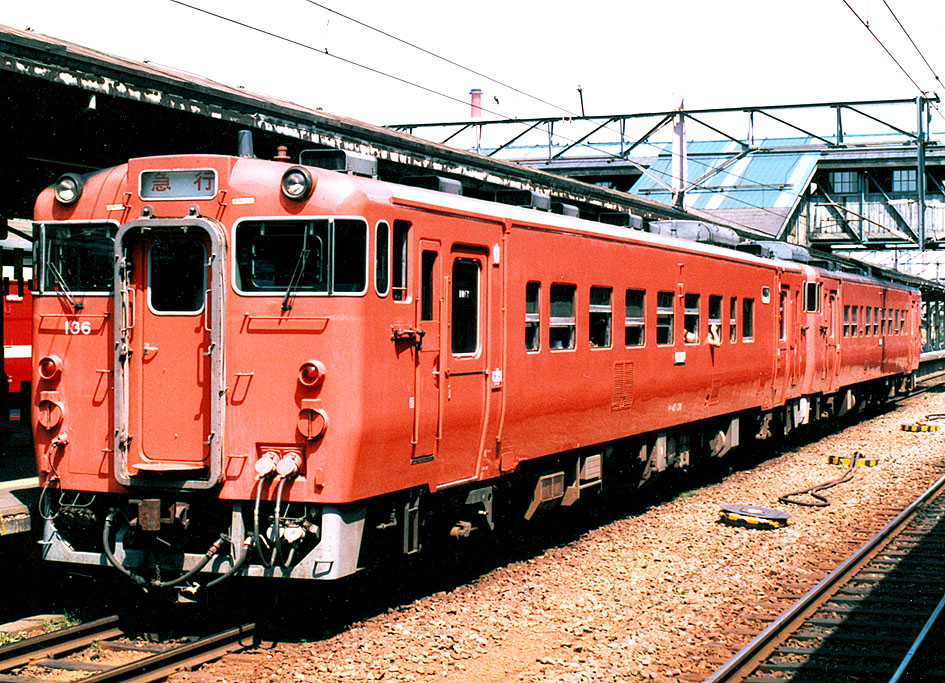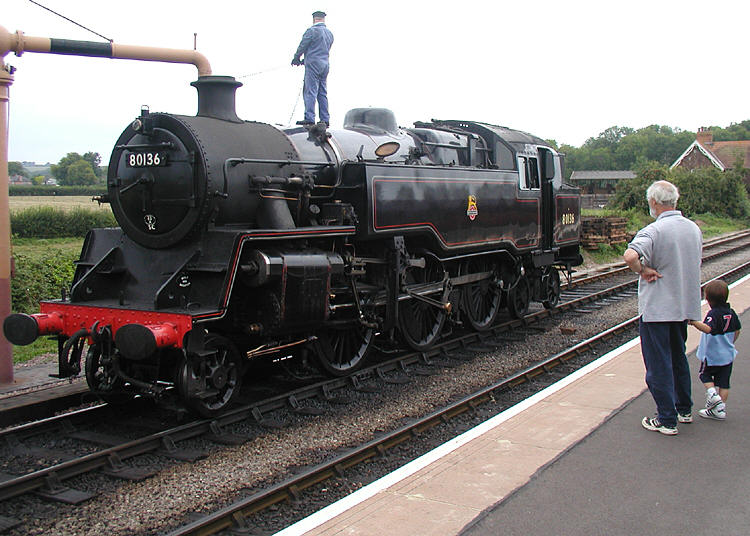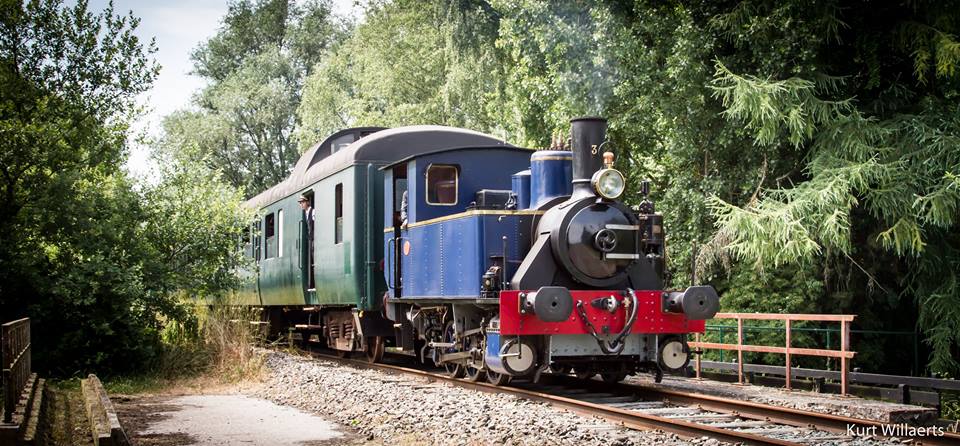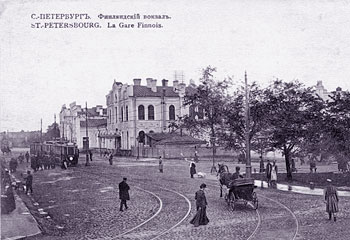|
VR Class Ds1
The VR Class Ds1 Also known as "Puumotti" (Roughly translated to Wood Cubic meter "motti" being a means to measure wood volume) was the first railbus of the Finnish State Railways. It was ordered in 1927. The Ds1 was built by the Pasila workshop, but the automotive parts including the engine were supplied by the Swedish company DEVA. Ds1 has a diesel engine and an electric drive, with a diesel generator providing power to the wheels. A cab is at either end of the vehicle, so that the vehicle did not have to be turned at terminal stations. The vehicle consisted of a motor room, a luggage compartment, and a 3rd class passenger compartment bare on a wooden bench seating. The Finnish State Railways started ordering Diesel multiple units and railcars, as road transport began to compete with rail passenger services. To compete with car and bus services the state railway added a number of train services and intermediate halts to its network. The use of steam locomotives on quiet railway li ... [...More Info...] [...Related Items...] OR: [Wikipedia] [Google] [Baidu] |
Finnish Railway Museum
The Finnish Railway Museum ( fi, Suomen Rautatiemuseo) is located in Hyvinkää, Finland. It was founded in 1898 and located in Helsinki Helsinki ( or ; ; sv, Helsingfors, ) is the Capital city, capital, primate city, primate, and List of cities and towns in Finland, most populous city of Finland. Located on the shore of the Gulf of Finland, it is the seat of the region of U .... The museum was moved to Hyvinkää in 1974. The museum is on the original station and yard site of the Hanko–Hyvinkää railway. In addition to the station building, there is a roundhouse and several other preserved buildings, mainly from the 1870s. The museum also has a live steam backyard railroad track, where train rides are offered to the public during special run days in the summer months. Exhibits See also * Jokioinen Museum Railway * Hanko–Hyvinkää railway External links Finnish Railway MuseumOfficial website* ttp://commons.wikimedia.org/wiki/Steam_locomotives_of_Finland P ... [...More Info...] [...Related Items...] OR: [Wikipedia] [Google] [Baidu] |
VR Group
VR-Group Plc ( fi, VR-Yhtymä Oyj, sv, VR-Group Abp), commonly known as VR, is a government-owned railway company in Finland. VR's most important function is the operation of Finland's passenger rail services with 250 long-distance and 800 commuter rail services every day. With 7,500 employees and net sales of €1,251 million in 2017, VR is one of the most significant operators in the Finnish public transport market area. VR was created in 1995 after being known as ''Suomen Valtion Rautatiet'' ('Finnish State Railways', sv, Finlands Statsjärnvägarna, russian: Финские государственные железные дороги) from 1862 to 1922, and ''Valtionrautatiet'' ('State Railways', sv, Statsjärnvägarna) from 1922 to 1995. As part of the concern, Avecra is a subsidiary for onboard catering service, Pohjolan Liikenne for bus traffic, VR Track for developing and maintaining of infrastructure and VR Transpoint for freight. Since 2017, its headquarters is loc ... [...More Info...] [...Related Items...] OR: [Wikipedia] [Google] [Baidu] |
Railbus
A railbus is a lightweight passenger railcar that shares many aspects of its construction with a bus, typically having a bus (original or modified) body and four wheels on a fixed base, instead of on bogies. Originally designed and developed during the 1930s, railbuses have evolved into larger dimensions, with characteristics similar in appearance to a light railcar, with the terms ''railcar'' and ''railbus'' often used interchangeably. Railbuses designed for use specifically on little-used railway lines were commonly employed in countries such as Germany, Italy, France, the United Kingdom and Sweden. Today, railbuses are being replaced by modern light DMU railcar designs. Modern diesel-electric railcars, which can be run coupled as multiple units, like the Stadler RS1, the RegioSprinter of Siemens or the successor Siemens Desiro share role and specifications with railbuses (albeit with improvements in noise, low floor design, fuel efficiency, speed and other measures) but ... [...More Info...] [...Related Items...] OR: [Wikipedia] [Google] [Baidu] |
Diesel Multiple Unit
A diesel multiple unit or DMU is a multiple-unit train powered by on-board diesel engines. A DMU requires no separate locomotive, as the engines are incorporated into one or more of the carriages. Diesel-powered single-unit railcars are also generally classed as DMUs. Diesel-powered units may be further classified by their transmission type: diesel–mechanical DMMU, diesel–hydraulic DHMU, or diesel–electric DEMU. Design The diesel engine may be located above the frame in an engine bay or under the floor. Driving controls can be at both ends, on one end, or in a separate car. Types by transmission DMUs are usually classified by the method of transmitting motive power to their wheels. Diesel–mechanical In a diesel–mechanical multiple unit (DMMU), the rotating energy of the engine is transmitted via a gearbox and driveshaft directly to the wheels of the train, like a car. The transmissions can be shifted manually by the driver, as in the great majority of first-ge ... [...More Info...] [...Related Items...] OR: [Wikipedia] [Google] [Baidu] |
VR Class Dm7
The Dm6 and Dm7 were diesel multiple units built by Valmet in the 1950s and 1960s for Valtionrautatiet. They are known by their nickname ''lättähattu'' (Finnish for "flat cap", the first widespread youth culture movement in Finland). History At the beginning of the 1950s it became clear that VR needed multiple units to compete with buses in short-distance traffic. In 1952, seven Dm6s were ordered from Valmet, and eight more the next year. After testing the Dm6:s and having noted that the new DMU:s worked well in Finnish conditions, VR ordered more units. In total, 197 Dm7 class multiple units were built with some modifications (a larger wheel size, for instance). Variants VR Class Dm7 recorded on 28 June 2018 DmG7 Three Dm7:s (numbers 4145–4147) were transformed into goods transport vehicles. They were withdrawn in 1981. Ttv 16 Dm7:s were transformed into electric maintenance vehicles. Preservation All Dm6:s have been withdrawn from service. 20 Dm7:s are preserv ... [...More Info...] [...Related Items...] OR: [Wikipedia] [Google] [Baidu] |
List Of Finnish Locomotives
This is a list of locomotives and multiple units that have been used in Finland. VR Group (privatised in 1995, previously ''Valtionrautatiet'', Finnish state railways) had a monopoly on passenger traffic until 1.1.2021, but is currently the only passenger operator on the Finnish rail network. Some trainsets are however owned by other companies such as or Karelian Trains. The Finnish railways, as with the Russian railways, are laid to the same gauge of . Electric locomotives Diesel locomotives Petrol-Paraffin locomotives Petrol-Paraffin locomotive references Data from: * Finnish Railway Museum official website Steam locomotives Steam locomotive references Data from: * Finnish Railway Museum official website * Finnish website with locomotive technical data Electric multiple units Diesel multiple units See also * Finnish Railway Museum * Hanko–Hyvinkää railway * History of rail transport in Finland * Jokioinen Museum Railway Literature * * R ... [...More Info...] [...Related Items...] OR: [Wikipedia] [Google] [Baidu] |
List Of Railway Museums
A railway museum is a museum that explores the history of all aspects of rail related transportation, including: locomotives (steam, diesel, and electric), railway cars, trams, and railway signalling equipment. They may also operate historic equipment on museum grounds. Africa Egypt *Egypt's Railway Museum (Cairo) Kenya *Nairobi Railway Museum in Nairobi Nigeria * NRC/Legacy Railway Museum in Lagos Sierra Leone * Sierra Leone National Railway Museum in Freetown South Africa *Outeniqua Transport Museum in George Sudan * Railway Museum in Atbarah Zambia *Railway Museum in Livingstone Zimbabwe *Bulawayo Railway Museum in Bulawayo Asia China *Chan T'ien-yu Memorial Hall, Badaling, Beijing *China Railway Museum, Beijing * Da'anbei Railway Station, Da'an, Jilin Province *Hong Kong Railway Museum * Qingdao-Jinan Railway Museum, Jinan, Shandong Province *Shanghai Railway Museum, Shanghai *Shenyang Railway Museum, Shenyang, Liaoning Province * Wuhan Metro Museum, Wuhan ... [...More Info...] [...Related Items...] OR: [Wikipedia] [Google] [Baidu] |
Heritage Railways
A heritage railway or heritage railroad (US usage) is a railway operated as living history to re-create or preserve railway scenes of the past. Heritage railways are often old railway lines preserved in a state depicting a period (or periods) in the history of rail transport. Definition The British Office of Rail and Road defines heritage railways as follows:...'lines of local interest', museum railways or tourist railways that have retained or assumed the character and appearance and operating practices of railways of former times. Several lines that operate in isolation provide genuine transport facilities, providing community links. Most lines constitute tourist or educational attractions in their own right. Much of the rolling stock and other equipment used on these systems is original and is of historic value in its own right. Many systems aim to replicate both the look and operating practices of historic former railways companies. Infrastructure Heritage railway lines ... [...More Info...] [...Related Items...] OR: [Wikipedia] [Google] [Baidu] |
List Of Heritage Railways
This list of heritage railways includes heritage railways sorted by country, state, or region. A heritage railway is a preserved or tourist railroad which is run as a tourist attraction, is usually but not always run by volunteers, and often seeks to re-create railway scenes of the past. Europe Austria * Ampflwanger Bahn (Timelkam — Ampflwang) * Bockerlbahn Bürmoos (narrow gauge, original tracks removed) * Bregenzerwaldbahn (narrow gauge, remaining section Bezau — Schwarzenberg) * Erzbergbahn (section Vordernberg — Eisenerz) * Feistritztalbahn (narrow gauge, Weiz — Birkfeld) * Gurktalbahn (narrow gauge, remaining section Treibach-Althofen — Pöckstein-Zwischenwässern) * Höllental Railway (Lower Austria) (narrow gauge, Payerbach-Reichenau — Hirschwang an der Rax) * Landesbahn Feldbach — Bad Gleichenberg (some regular service remains) * Lavamünder Bahn (Lavamünd — St. Paul im Lavanttal, track removed) * Lokalbahn Ebelsberg — St. Florian (narrow gaug ... [...More Info...] [...Related Items...] OR: [Wikipedia] [Google] [Baidu] |
Restored Trains
Conservation and restoration of rail vehicles aims to preserve historic rail vehicles. Trains It may concern trains that have been removed from service and later restored to their past condition, or have never been removed from service, like UP 844, the only U.S. steam locomotive to never be retired. They are often operated in present-day service as moving examples of living history, as opposed to static exhibits. The majority of restored trains are operated at heritage railways and railway museums, although they can also be found on the main lines or branch lines of the commercial working railway, operated by specialist railtour companies or museum groups. For authenticity, the location/route of preserved trains is often chosen to match the original trains used. Heritage railways and railway museums aim to restore and operate restored trains. Trains are often restored to the original authentic livery of their original owner. In the United States The restoration of historic r ... [...More Info...] [...Related Items...] OR: [Wikipedia] [Google] [Baidu] |
Jokioinen Museum Railway
The Jokioinen Museum Railway is located in Jokioinen, Finland. It is located on the last operating commercial narrow gauge railway in Finland, the gauge Jokioinen Railway. The museum was established on February 2, 1978, four years after the discontinued operation of the commercially-operated railway, when the new Jokioinen Museum Railway Limited joint stock company ( fi, Jokioisten Museorautatie Oy) bought the rail line from Jokioinen to Minkiö railway station, with its land and associated buildings. Museum steam trains began running that same year. In 1994 the line was extended with an stretch between Minkiö and Humppila. The museum railway station at Humppila is beside the station of the Turku- Toijala VR line, providing a convenient access to the museum. The Minkiö station has a narrow gauge museum with a collection of carriages and locomotives. There are a number other attractions in the vicinity of the railway. Gallery File:Jokioinen railway no. 4.jpg, A 2-6 ... [...More Info...] [...Related Items...] OR: [Wikipedia] [Google] [Baidu] |
History Of Rail Transport In Finland
:''This article is part of the history of rail transport by country series'' The history of rail transport in Finland began on January 31, 1862, with the opening of the railway line between Helsinki and Hämeenlinna. By 1900 most of the future main lines had been constructed, including the line to St. Petersburg.4rail.net - Reference - Finland - Railway History ''4rail.net'' By the time of the birth of the new Finnish Republic in 1917 lines connected all major cities, major ports, and reached as far as the Swedish border, and inner Finland as far north as Kontiomäki in Paltamo region, as well as eastwards into Karelia. Rail ...
|
